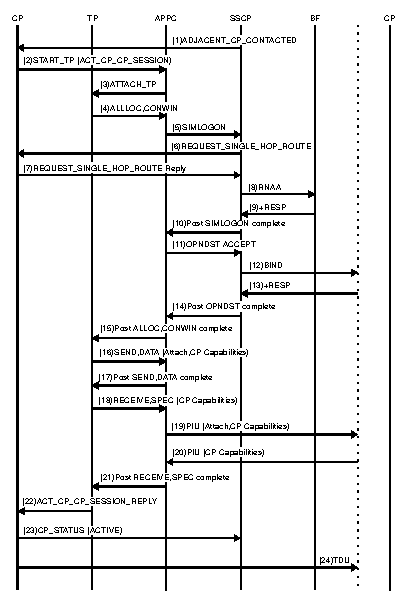 |
Figure 1. CP-CP contention-winner session activation
- Configuration services sends an ADJACENT_CP_CONTACTED signal to
the CP when the first link supporting CP-CP sessions is activated
with an adjacent CP.
- The CP sends a START_TP signal to the APPC PAB to request initiation
of the Request CP Capabilities Transaction Program (TP). An ACT_CP_CP_SESSION
request is queued to the START_TP signal for processing by the Request
CP Capabilities TP. The ACT_CP_CP_SESSION initiates the activation
of a contention winner CP-CP session with an adjacent node.
- APPC sends an ATTACH_TP AMU for the Request CP Capabilities TP
to TP Services.
- The Request CP Capabilities TP issues an APPCCMD CONTROL=ALLOC,
QUALIFY=CONWIN macroinstruction to allocate a conversation between
the TP and the partner TP and a contention winner session between
the local LU and the remote LU.
- APPC issues a VTAM® SIMLOGON
macroinstruction to initiate a session in which APPC acts as the PLU.
- Subarea session services sends a REQUEST_SINGLE_HOP_ROUTE signal
to the CP to request the least-weight single-hop route from the origin
to the destination.
- The CP sends to subarea session services the information requested
in a REQUEST_SINGLE_HOP_ROUTE_REPLY.
- RNAA flows if the CP-CP session is being set up over a type 2.1
link and a network address is needed. If the CP-CP session is being
set up over a VR-based transmission group, CDINIT format 5 is sent
to the session partner to get a network address.
- The response is received from the boundary function.
- LUS posts the SIMLOGON complete.
- APPC issues an OPNDST ACCEPT macroinstruction to continue establishment
of a session between APPC in this node (acting as the PLU) and APPC
in the adjacent node (acting as the SLU).
- The BIND for the contention winner session is transmitted to the
adjacent node.
- The BIND response for the contention winner session is received
from the adjacent node.
- LUS posts the OPNDST ACCEPT complete.
- APPC posts the APPCCMD CONTROL=ALLOC,QUALIFY=CONWIN complete,
supplying the Request CP Capabilities TP a conversation ID and a contention
winner conversation group ID (CGID).
- The Request CP Capabilities TP issues an APPCCMD CONTROL=SEND,
QUALIFY=DATA macroinstruction to initiate the sending of the CP Capabilities
data to the adjacent CP.
- APPC posts the APPCCMD CONTROL=SEND,QUALIFY=DATA instruction complete,
indicating that the output buffer has been filled with the CP Capabilities
data.
- At the request of the Request CP Capabilities TP, the Receive
and Check CP Capabilities TP issues an APPCCMD CONTROL=RECEIVE, QUALIFY=SPEC
macroinstruction to cause the transmission of the CP Capabilities
data to the adjacent CP, and to initiate the receiving of CP Capabilities
data from the adjacent CP.
- APPC sends to the adjacent node a PIU with the CP Capabilities
data. The PIU also carries a request that TP services in the adjacent
node attach its CP Capabilities TP.
- APPC receives from the adjacent node a PIU containing the CP Capabilities
of the adjacent CP.
- APPC posts the APPCCMD CONTROL=RECEIVE,QUALIFY=SPEC macroinstruction
complete.
- The Request CP Capabilities TP responds to the successful completion
of the RECEIVE macroinstruction by sending to the CP an ACT_CP_CP_SESSION_REPLY,
which contains both the contention winner CGID and the CP Capabilities
data received from the adjacent CP.
- If both the contention winner and contention loser CP-CP sessions
are active, the CP sends a CP_STATUS(ACTIVE,BOTH) signal to configuration
services.
- If both CPs are network nodes, a topology database update (TDU)
will flow when the contention winner session is active. The TDU is
used to update the partner regarding changes to network topology that
have occurred since the two CPs were last in session.
If the network
node server is a VTAM, a TDU
will also flow over the contention winner session from a VTAM end node to its network node server. This
TDU carries information about changes that have occurred to the end
node connections since the end node and the network node server were
last in session.



|
 z/OS Communications Server: SNA Diagnosis Vol 1, Techniques and Procedures
z/OS Communications Server: SNA Diagnosis Vol 1, Techniques and Procedures
 z/OS Communications Server: SNA Diagnosis Vol 1, Techniques and Procedures
z/OS Communications Server: SNA Diagnosis Vol 1, Techniques and Procedures




 Copyright IBM Corporation 1990, 2014
Copyright IBM Corporation 1990, 2014